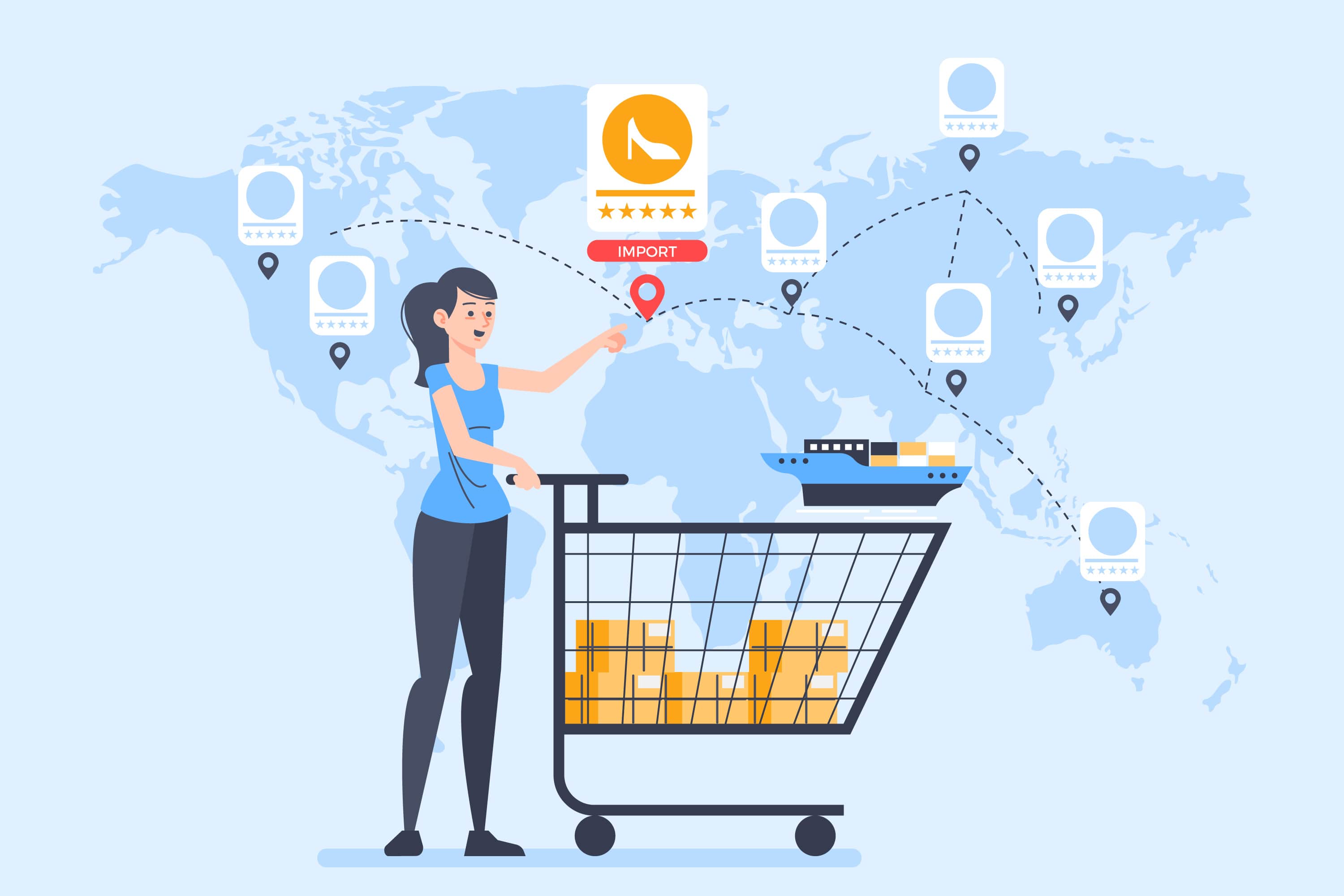The world is your oyster, thanks to the internet and the global marketplace.
No matter how big or small your business is, you can reach out to customers across the globe and grow your sales. One of the best ways to do that is through cross-border e-commerce. In this blog, we’ll take you on a journey through the thrilling world of cross-border e-commerce, where you’ll discover its benefits, challenges, and the essential strategies to make it work for you.
Cross-border e-commerce is the practice of selling products or services online to customers in other countries. It is a fast-growing and lucrative sector, with global e-commerce sales expected to grow rapidly in the coming years.
Cross-border e-commerce offers many benefits for both businesses and consumers, such as access to new markets, increased customer base, lower operational costs, and greater product variety. However, cross-border e-commerce also poses some challenges, such as language and cultural barriers, logistics and delivery issues, legal and regulatory compliance, and payment and currency differences.

To overcome these challenges, businesses need to adopt effective strategies and tools that can help them navigate the complex world of cross-border e-commerce.
The Global E-Commerce Boom
 The Global E-
The Global E-
You need to grasp the context before you dive into cross-border e-commerce. E-commerce has been exploding in the last decade. According to eMarketer, the world shelled out $4.28 trillion on e-commerce in 2020, and this number is projected to climb to $6.39 trillion by 2024.
This e-commerce craze is not just happening within countries. Cross-border e-commerce, or the art of selling products or services online to customers in different corners of the world, is flourishing. In 2020, cross-border e-commerce sales hit $1.9 trillion, making up almost half of all e-commerce sales globally.
The Benefits of Cross Border E-Commerce

Why should your business consider expanding globally through cross-border e-commerce? Let’s explore the numerous advantages:
-
Access to a Vast Customer Base
Cross-border e-commerce lets you reach customers beyond your borders. While your local or regional market might have limits, selling internationally means you can connect with potential customers all over the world. This not only expands your customer base but also diversifies your income sources, making your business more robust.
-
Increased Revenue Potential
Going global can make your revenue soar. According to a McKinsey report, businesses that sell online to customers in different countries grow 1.6 times faster than those that don’t. This revenue boost is because you can reach more customers and meet their specific needs in different markets.
-
Brand Visibility and Recognition
Global business can make your brand shine and stand out. A strong international presence can make your business look more trustworthy and impressive, potentially drawing more customers both at home and abroad.
-
Diversification and Risk Mitigation
Putting all your eggs in one basket can be dangerous. If one market goes south, your business can suffer. Going global through cross-border e-commerce lets you spread your risks, making sure your business stays strong even in tough times.
-
Competitive Advantage
In a globalized world, you need to be flexible to stay ahead of the game. Businesses that sell online to customers in different countries have an edge over their rivals by being nimble and adaptable to changing market trends. Your ability to reach new markets and cater to local tastes can make you stand out from the crowd.
The Challenges of Cross-Border E-Commerce
While the opportunities are enticing, it’s essential to acknowledge the challenges that come with cross-border e-commerce:
- Regulatory Compliance
Dealing with international rules and customs can be a headache. Different countries have different hoops and hurdles for imports, taxes, and product safety standards. If you don’t follow them, you could face delays, fines, or even legal trouble.
- Language and Cultural Barriers
Knowing the local languages, cultures, and consumer preferences is key. You need to communicate and market your products or services in a way that connects with the target audience and makes them want to buy.
- Payment and Currency Issues
Handling different currencies and payment methods can be a challenge. You need to provide safe and easy payment options that suit the needs of customers in each market.
- Shipping and Logistics
Sending products across the world comes with challenges such as shipping costs, delivery times, and customs procedures. You need to make sure your supply chain is smooth and affordable for your customers.
- Competition and Market Saturation
When you go global, you’ll have to deal with rivals from near and far. You’ll need a solid reason for customers to choose you over them and a clever way to get your message across. Otherwise, you’ll be lost in the crowd.
Strategies for Successful Cross Border E-Commerce

To thrive in the world of cross-border e-commerce, you need a well-thought-out strategy. Here are the key steps to consider:
- Market Research
Don’t dive into a new market without doing your homework. Find out what the locals want and need from your products or services, who you’re up against, and how to fit in with their culture. Know your audience and customize your offerings accordingly.
- Regulatory Compliance
Don’t get caught up in red tape when you trade across borders. Seek advice from experts or lawyers to follow the rules. Think about hiring customs agents or shipping partners who know the ropes of international trade.
- Localization
Localization means making your website, product descriptions, and marketing materials fit for the target market. This means speaking their language, showing their money, and appealing to their culture in your branding.
- Payment and Currency Solutions
Give your customers the freedom to pay the way they want in different regions. Work with payment processors that can handle all kinds of money and payment methods safely.
- International Shipping
Pick trustworthy shipping and logistics partners to make sure your products reach your customers smoothly. Be clear about shipping details to customers, including how long it will take and how much they might have to pay for customs.
- Customer Support
Speak to your customers in their own languages with multilingual customer support. Quickly solve their questions and problems to earn their trust and loyalty.
Success Stories: Brands Thriving in Cross-Border E-Commerce

To illustrate the potential of cross-border e-commerce, let’s take a look at some success stories:
-
Alibaba Group
Alibaba, the Chinese e-commerce giant, has gone beyond its borders to reach customers around the world. Through platforms like AliExpress and Taobao Global, Alibaba lets Chinese sellers offer their goods to global buyers. Their efforts to adapt to local markets accept different payment methods, and ship reliably have made them a global success
-
Amazon
Amazon is a shining star of cross-border e-commerce. It has a presence in over 200 countries and regions, with websites that suit each market and a huge range of products. Amazon Prime, with its speedy and dependable global shipping, has made it a favorite for shoppers around the world.
-
Etsy
Etsy is not your ordinary online store. It’s a global hub for artisans and vintage lovers who craft and curate products that are unique, authentic, and full of personality. Whether you’re looking for a hand-knitted sweater, a vintage vinyl record, or a personalized necklace, you’ll find it on Etsy. That’s why millions of shoppers around the world choose Etsy as their destination for one-of-a-kind goods.
Summing Up

Cross-border e-commerce is not a walk in the park. You need to do your homework, follow the rules, and cater to your customers. That means doing thorough market research, dealing with regulatory issues, and localizing your products and services. You also need to use data analytics to keep track of your performance and fine-tune your strategies as the market changes.
If you want to grow your business in the 21st century, you can’t afford to stay within your borders. You need to go global and tap into the huge potential of cross-border e-commerce. Sure, there are some hurdles to overcome, but the rewards are worth it. You’ll be able to reach more customers, boost your sales, and reduce your risks.
Cross-border e-commerce is not a nice-to-have; it’s a must-have for any savvy business owner!

